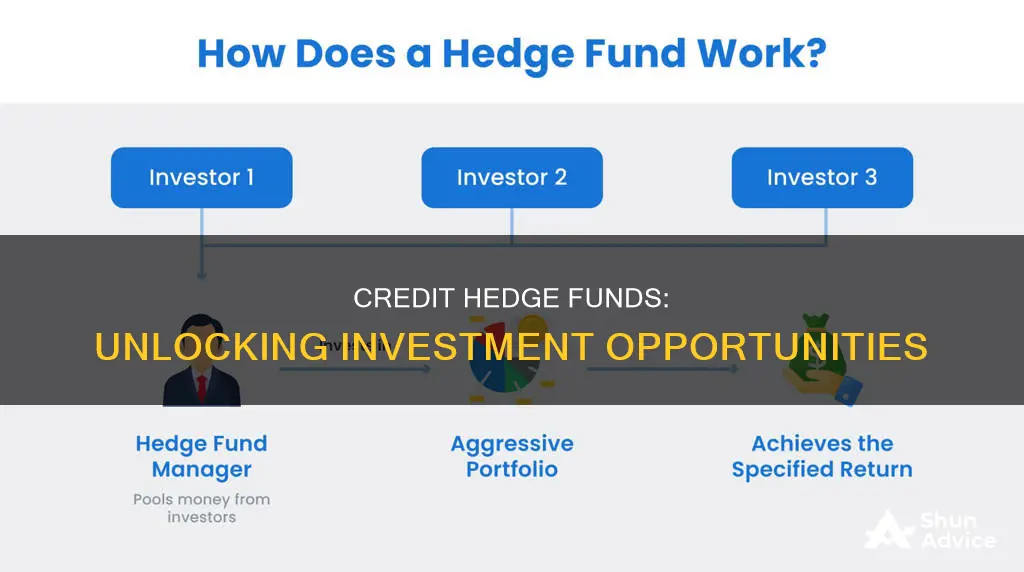
Credit hedge funds are a type of investment vehicle that focuses on generating returns by investing in various debt instruments, such as fixed-income securities. These funds employ different strategies, including long/short credit, securitized credit, and distressed credit, to pursue attractive absolute and risk-adjusted returns. They invest in a range of fixed-income instruments, including bank loans, corporate and government bonds, distressed debt, and securitized credit. Credit hedge funds are known for their complex strategies and the need to understand legal documentation, making them less accessible to the average investor. However, they offer a great career path for those with the right knowledge and experience.
| Characteristics | Values |
|---|---|
| Definition | Credit hedge funds buy and sell fixed-income securities, such as high-yield bonds, distressed bonds, structured credit, and their derivatives |
| Example | Long one bond and short a similar bond issued by a peer company |
| Types | Long/Short Credit, Structured Credit, Distressed |
| Trading vs. Investing | Trading-focused funds deal with more-liquid credits, hold more positions, use shorter holding periods, and more leverage; investing-focused funds deal with less-liquid credits, hold fewer positions, and use longer holding periods |
| Primary focus | Credit hedge funds can do anything from long-term holding to long/short trades to complex trades involving derivatives |
| Liquidity | Less liquidity and longer lock-up periods |
| Time Horizon | Days/weeks/months for trading-style funds or multiple years for funds that focus on distressed bonds |
| Leverage | Low-to-moderate leverage |
| Net Exposure and Beta | Moderate net exposure and beta |
| Portfolio Concentration | Depends on fund type; dozens of positions at multi-manager, trading-focused funds, and more concentrated portfolios at single-manager, stressed or distressed-focused ones |
| Performance | Average credit hedge fund outperformed the average fund in other categories on a risk-adjusted basis but trailed benchmarks like the high-yield index |
| Investors | Wealthy individuals, pension funds, and institutional investors |
What You'll Learn

Long/short credit
A long/short credit hedge fund can be used to express an investment thesis in several ways. For example, a manager could go long and short in credit instruments of the same company with different maturities, buying a company's one-year bond and selling its 10-year bond if they believe the company's creditworthiness is stronger in the near term but riskier in the future. This is typically referred to as a capital structure trade.
Managers may also take long and short positions in different credit instruments, such as buying a corporate bond and shorting a credit index, to express a view that a particular company's credit will outperform a broader universe of credit securities. Another example is a relative value trade, where the manager buys the debt of one company while shorting another company's debt. This strategy is often used with issuers operating in the same industry with bonds of similar maturities, and the belief that one company's credit strength is superior to its peer.
Historically, long/short credit hedge funds have benefited from lower correlations and higher dispersion within the fixed-income market, providing an environment for greater return potential. This strategy can provide absolute returns, increased alpha, and a low correlation with other asset classes.
The long/short credit strategy is based on a broad investment universe. Firstly, at a geographical level, it has a worldwide scope. Secondly, at the asset class level, it includes investment grade, high yield, convertible, or distressed securities. Finally, at the instrument level, it includes cash bonds, credit derivatives, or bank loans—any securities directly or indirectly linked to an issuer's ability to repay debt.
The long/short credit strategy aims to take advantage of opportunities in the credit space, regardless of the market environment. It seeks exposure to credit-sensitive securities, long and/or short, mainly based on the credit analysis of issuers and securities and on credit market views.
Index Funds in India: Risky Business
You may want to see also

Securitized credit
The securitization process involves loan originators/providers pooling similar loans together, and then selling those pools in slices to investors. The process can differ depending on the underlying collateral type, but generally, it entails the following steps:
- Issuers accumulate similar loans that could be readily pooled together.
- Once the amount of loan has grown to a sufficient size, the issuer can hire an investment bank to start the process of creating, structuring, and then selling the securitization.
- The issuer creates a trust that will hold the underlying loans, so they are no longer part of the issuers' or bank's balance sheet.
- To finance those loans, the trust issues liabilities, which are the securitization bonds in question.
- The bank/underwriter begins looking for investors in the public market to purchase those securitization bonds.
- Depending on investor feedback/demand, the structuring bank will adjust the terms as necessary.
Securitized products are typically sold in tranches, where each tranche higher in the capital structure has a more senior right to the cash flows and principal payments of the underlying loans than tranches lower in the capital structure. The securitization structure is designed to protect senior tranches from losses. However, junior tranches are compensated for taking additional risk. Investors who take a higher risk when buying lower-positioned tranches earn a higher level of compensation. This creates "credit support" or "credit enhancement", where the senior bonds have their credit risk supported or enhanced by having losses absorbed elsewhere in the capital structure.
Mortgage-Backed Securities (MBS)
MBS are debt obligations representing claims to the cash flows from pools of mortgage loans, most commonly on residential property. There are several types of MBS, including agency MBS, which are mortgage bonds guaranteed by one of three US federal agencies: the Federal Home Loan Mortgage Association ("Freddie Mac"), the Federal National Mortgage Association ("Fannie Mae"), and the Government National Home Loan Association ("GNMA", or "Ginnie Mae").
Commercial Mortgage-Backed Securities (CMBS)
CMBS are bonds backed by loans on commercial properties, most commonly in the office, multifamily, industrial, retail, and hotel sectors. CMBS can come in a wide variety of different structures and underlying collateral types but are typically grouped into four main categories:
- CMBS that are backed by a diversified pool of mortgage loans secured by commercial real estate properties, from a variety of different borrowers.
- Single-Asset/Single Borrower (SASB) CMBS that are backed by one mortgage loan on either a single asset or a single portfolio of commercial real estate assets, owned by one borrower.
- Commercial Real Estate Collateralized Loan Obligations (CRE CLOs) that are typically made up of underlying commercial real estate loans that are made to commercial properties undergoing stabilization or redevelopment.
- Agency CMBS, which are only exposed to multifamily commercial real estate and some healthcare properties.
Asset-Backed Securities (ABS)
In the context of securitized credit, ABS are typically backed by consumer loans such as auto loans, student loans, or credit card receivables. ABS can also be backed by rental car receivables, credit card receivables such as interest and fees, and undergraduate and graduate student loans.
Collateralized Loan Obligations (CLOs)
CLOs are structured credit products that are backed by 1st lien, high-yield-rated corporate syndicated leveraged loans ("bank loans"). Pools of typically 200-300 bank loans are grouped together and sold to investors in a variety of different tranches, each with a varying degree of risk and return. CLOs differ from other securitized credit products in that the pool of bank loans that constitute a CLO is actively managed by the investment manager that issues the CLO.
Strategies for Investing in Ray Dalio's Principles Fund
You may want to see also

Distressed credit
Investing in distressed debt is a risky strategy as it involves companies with a high risk of insolvency. However, distressed credit hedge funds can limit their risk by taking relatively small positions in distressed companies. The potential for high returns is particularly attractive to these funds, and they can generate substantial profits if the distressed company is successfully restructured or rejuvenated.
Some of the top distressed credit hedge funds include Aurelius Capital, Elliott Associates, Solus Alternative, Marathon Asset Management, and Silver Point Capital.
Search Funds: A Guide to Getting Started with Investing
You may want to see also

High-yield bonds
The risk associated with high-yield bonds primarily revolves around the possibility of default, where the issuer may struggle to make scheduled interest and principal payments on time. Historically, the default rate in the high-yield sector of the US bond market has averaged around 5%. During the COVID-19 pandemic, for instance, default rates rose to just under 9%.
Despite the risks, high-yield bonds present an attractive investment opportunity for credit hedge funds. Institutional investors, such as pension funds, mutual funds, banks, and insurance companies, are the largest purchasers of these bonds. Individual investors also participate in the high-yield sector, primarily through mutual funds.
- Long/Short: These hedge funds employ a strategy where they take long and short positions in a security, industry, or market. They express a view that certain investments will move positively (long) or negatively (short).
- Securitized: Securitized credit instruments are fixed-income securities backed by portfolios of income-generating assets. Managers of securitized credit funds aim to exploit pricing inefficiencies and periodic dislocations in structured credit instruments such as mortgage-backed securities (MBS), asset-backed securities (ABS), and collateralized loan obligations (CLO).
- Distressed: Distressed credit funds invest in the debt of companies facing bankruptcy or a high likelihood of bankruptcy. These funds aim to purchase distressed bonds at a significant discount or work directly with distressed companies to provide funding and facilitate their financial recovery.
Credit hedge funds that invest in high-yield bonds offer the potential for attractive absolute and risk-adjusted returns. They provide exposure to various fixed-income instruments, including corporate and government bonds, while also allowing funds to express their views on the relative creditworthiness of companies through long/short strategies.
Mutual Funds: To Stay or To Stray?
You may want to see also

Structured credit
The securitization process allows issuers of structured credit products to benefit from potential off-balance sheet treatment of assets, reduction of an asset-liability mismatch, and lower financing costs. For example, a BB-rated company can carve out AA-rated assets as collateral, enabling it to borrow at lower rates.
- Greater return potential: Structured credit products typically offer attractive yield premiums relative to conventional fixed-income products due to their increased complexity.
- Low loss rates: Certain structured products, such as collateralized loan obligations (CLOs) and categories of commercial mortgage-backed securities (CMBS), have historically had lower loss rates than other credit investment products.
- Diversification: Structured products are bundles of multiple contractual obligations, with many unique borrowers, providing significant diversification in the sources of cash flow and a high level of defense against potential losses. Additionally, subsectors within the structured credit asset class have historically had low correlations with one another and with traditional fixed-income sectors.
- Structural protections: Securitization typically includes credit enhancement and various other safeguards that help reduce the credit risk of an issue, such as subordination, overcollateralization, and excess spread.
However, investing in structured credit also carries certain risks, including:
- Complexity: Securitization takes relatively simple debt contracts and packages them into more complex structures, which may require greater investment understanding and resources.
- Credit and default risk: Despite a high level of transparency into the individual loans, the risk of loss due to adverse developments in the performance of the underlying collateral cannot be eliminated.
- Interest rate risk: Changes in interest rates may affect the value of a structured security prior to its maturity.
- Reduced liquidity and marketability: Structured credit products are complex securities that may trade infrequently and, therefore, be difficult to price and liquidate.
Monthly Mutual Fund Investments: $50 Well Spent
You may want to see also
Frequently asked questions
The three main types of credit hedge fund strategies are: Long/Short, Securitized, and Distressed.
Credit hedge funds invest in a variety of debt instruments, including bank loans, corporate, municipal and government bonds, distressed debt, and securitized credit.
Some examples of credit hedge funds include Citadel, Farallon Capital Management, and Elliott Investment Management.







